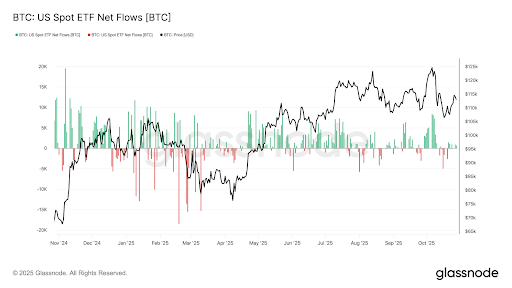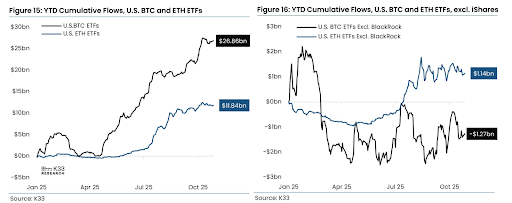Bitcoin ETF inflows are rebounding modestly in 2025, led by BlackRock’s iShares Bitcoin Trust with $28.1 billion in net additions, signaling cautious institutional adoption amid Bitcoin’s price stability near $113,000.
-
Bitcoin ETFs see daily inflows of $202.48 million, pushing total assets under management to $154.81 billion.
-
BlackRock dominates with strong investor preference for its efficient structure over legacy funds.
-
Grayscale’s GBTC faces ongoing outflows of $24.62 billion since 2024, highlighting shifts in market dynamics with 26.9 billion total ETF inflows this year.
Discover how Bitcoin ETF inflows are surging under BlackRock’s lead in 2025, boosting institutional confidence. Explore key trends and implications for crypto investors today.
What Are Driving Bitcoin ETF Inflows in 2025?
Bitcoin ETF inflows are experiencing a gradual resurgence driven by renewed institutional interest and Bitcoin’s price recovery above $107,000. Data from Glassnode indicates that spot Bitcoin ETFs attracted modest daily inflows of less than 1,000 BTC, a fraction of the 2,500 BTC seen in previous bull markets, yet signaling steady demand. This cautious momentum underscores Bitcoin’s evolving role as a stable portfolio asset rather than a high-risk speculation.
Bitcoin ETFs in the U.S. are starting to pick up again after a quiet stretch, showing that investors are slowly regaining confidence. Data from Glassnode shows Bitcoin’s recent price rebound from $107,000 came right as money started flowing back into spot ETFs.
- Bitcoin ETFs are slowly regaining strength as inflows rise again, but demand still trails far behind past bull cycles.
- BlackRock’s iShares Bitcoin Trust dominates the market, driving nearly all ETF inflows and shaping investor confidence.
- Grayscale’s GBTC continues to bleed funds, showing investors prefer more efficient and trusted Bitcoin ETF options.
Still, the inflows are small—less than 1,000 BTC a day—compared to the 2,500 BTC seen during past major rallies. This means interest is returning, but the excitement hasn’t fully come back yet.

Source: Glassnode
The renewed ETF activity reflects ongoing institutional interest, though investors seem more selective this cycle. Data from SoSoValue shows Bitcoin ETFs recorded a $202.48 million daily net inflow, pushing total managed assets to around $154.81 billion.
During the same period, Bitcoin traded near $113,689, maintaining relative price stability despite brief fluctuations. Hence, capital continues to flow steadily into Bitcoin ETFs, reinforcing the view that institutions now see Bitcoin as a core investment asset rather than a speculative trade.

Source: Sosovalue
How Is BlackRock Leading Bitcoin ETF Inflows?
BlackRock’s iShares Bitcoin Trust (IBIT) has emerged as the undisputed frontrunner in the Bitcoin ETF space, capturing the bulk of investor capital with its robust infrastructure and regulatory compliance. According to Vetle Lunde, Head of Research at K33, Bitcoin ETFs have attracted $26.9 billion in net inflows this year, with IBIT alone accounting for $28.1 billion—effectively propping up the entire sector. This leadership is evident in recent data, where IBIT’s daily inflows significantly outpaced competitors, reflecting strong trust from both retail and institutional investors who prioritize low fees and high liquidity.
Without BlackRock’s contribution, aggregate ETF inflows would dip into negative territory, underscoring the firm’s pivotal role in sustaining market momentum. Lunde further notes that this concentration of flows highlights a maturing market where established players like BlackRock benefit from their scale and reputation. Meanwhile, the overall assets under management for Bitcoin ETFs have climbed to $154.81 billion, a testament to the growing acceptance of cryptocurrency within traditional finance portfolios.

Source: Vetle Lunde
In contrast, Grayscale’s GBTC continues to struggle. The fund has not recorded a single month of positive flows since its January 2024 conversion. GBTC has lost about $24.62 billion in cumulative outflows, severely weighing on the sector’s overall performance.
Moreover, analysts note that removing both IBIT and GBTC from aggregate figures would leave the ETF market slightly positive, though not significantly. This dynamic illustrates a clear bifurcation: innovative, cost-effective products like IBIT are drawing capital away from higher-fee alternatives, fostering a more competitive and efficient ecosystem. Industry observers, including those from the Financial Times, emphasize that such trends could accelerate Bitcoin’s integration into mainstream investment strategies, with projections for continued growth as regulatory clarity improves.
Beyond BlackRock, other major players like Fidelity and ARK Invest have seen sporadic inflows, but none match the consistency of IBIT. For instance, Fidelity’s Wise Origin Bitcoin Fund recorded smaller net additions, aligning with broader patterns of selective investing. This selectivity is informed by Bitcoin’s historical volatility, now tempered by ETF accessibility, which allows investors to gain exposure without direct custody risks. Experts like those at Bloomberg Intelligence predict that as Bitcoin stabilizes around current levels, inflows could accelerate, potentially reaching new highs by year-end.
Frequently Asked Questions
What Factors Are Influencing Current Bitcoin ETF Inflows?
Current Bitcoin ETF inflows are influenced by Bitcoin’s price stability near $113,000, institutional demand for diversified assets, and confidence in regulated products like spot ETFs. Data from SoSoValue highlights $202.48 million in daily nets, driven by low-fee options that appeal to long-term holders seeking exposure without direct crypto ownership.
Why Is BlackRock’s Bitcoin ETF Outperforming Competitors?
BlackRock’s iShares Bitcoin Trust outperforms due to its massive scale, competitive fees, and strong brand trust among investors. As Vetle Lunde from K33 explains, IBIT has single-handedly driven $28.1 billion in inflows this year, far surpassing rivals amid a market where efficiency and liquidity are paramount for institutional participation.
Key Takeaways
- Modest Rebound in Inflows: Bitcoin ETFs are seeing daily nets of $202.48 million, indicating renewed but cautious investor interest following price recoveries.
- BlackRock’s Dominance: IBIT leads with $28.1 billion in additions, highlighting the importance of trusted, low-cost structures in attracting capital.
- Grayscale Challenges: GBTC’s $24.62 billion outflows since 2024 underscore the need for innovation to retain investor flows in a competitive landscape.
Conclusion
In summary, Bitcoin ETF inflows are regaining traction in 2025, propelled by BlackRock’s leadership and steady institutional adoption, even as challenges like Grayscale’s outflows persist. This shift toward efficient vehicles reinforces Bitcoin’s status as a viable asset class. As market dynamics evolve, investors should monitor regulatory developments and price trends for opportunities to engage with this growing sector.
